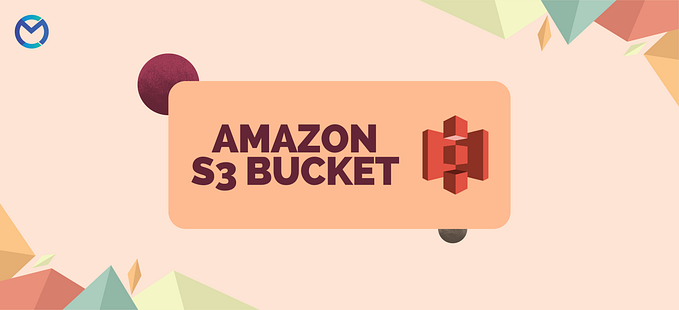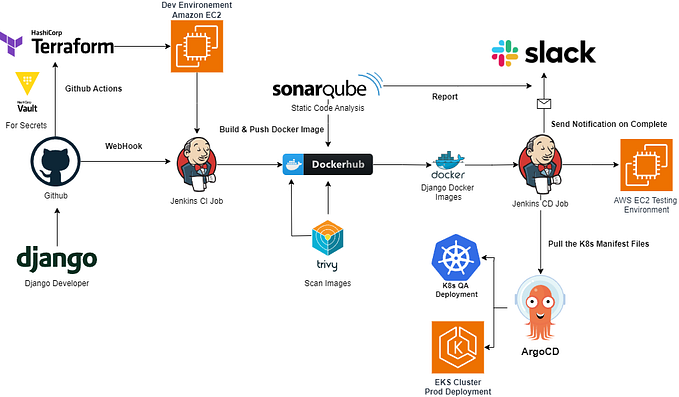For S3 Buckets, CloudFront Distributions, EC2 Instances, Route 53 Record Sets, EC2 Instance, and associated EBS Volumes
Creating Cloud Formation template for setup
1)S3 Bucket setup steps
For File and Frontend (UI) Bucket
- Bucket name as per there requirement
- Region should be always Mumbai
- Object owenership should be ACLs enabled
- Object owener preferred
- Block all public access
- Bucket versoning should be disable
- Default encryption as usual
- Create bucket
2)Cloudfront setup steps for Frontend (UI) Bucket
- Create distribution
- Select S3 Frontend bucket as a origin domain
- Origin access:- Origin access control settings (recommended)
- Origin access control take or Create new OAC
- Copy S3 Bucket policy and Go to S3 bucket permissions
- Default cache
- Viewer protocol policy — Redirect HTTP to HTTPS
- For S3 Allowed HTTP methods — GET, HEAD, OPTIONS
- Cache key and origin request — caching disabled
- Origin request policy CORS-S3Origin
- WAF enabled
- CNAME as per requirement
- Select Custom SSL Certificate
- Don’t forget to tag them
- Give path index.html (default root object)
- For frontend bucket standard logging and cookies ON
- In standard logging add S3 bucket dump in S3 bucket file and add log prefix mm-00*/ui/
3)Cloudfront setup steps for ALB(Application Load Balancer)
- Create distribution
- Select ALB as a origin domain
- Origin access:- Origin access control settings (recommended)
- Origin access control take or Create new OAC
- Default cache
Choose ALB on origin domain
- Protocol HTTP only
- Viewer policy Redirect HTTP to HTTPS
- For ALB GET, HEAD, OPTIONS, PUT, POST, PATCH, DELETE
- Cache Policy: CachingDisabled
- Origin request policy — AllViewerAndCloudFrontHeaders-2***–0*
- WAF enabled
- Create
- In ALB cdn standard logging and cookies logging should be ON
- In standard logging add S3 bucket dump in S3 bucket file and add log prefix mm-00*/api/
4) Cloudfront setup steps for Files
- Create distribution
- Select S3 Files bucket as a origin domain
- Origin access:- Origin access control settings (recommended)
- Origin access control take or Create new OAC
- Default cache
- Viewer protocol policy — Redirect HTTP to HTTPS
- For S3 Allowed HTTP methods — GET, HEAD, OPTIONS
- Cache key and origin request — (Create new cache policy or use existing)
- Origin request policy CORS-S3Origin
- WAF diasbled
- CNAME as per requirement
- Select Custom SSL Certificate
- Don’t forget to tag them
- In FILE cdn standard logging and cookies logging sholud be off
5) EC2 instance setup
- Go to the AMI
- Select AMI ******(name)
- take t4g.small instance type
- Click instance from AMI
- Name to instance
- Select size
- Edit network setting Auto-assign public IP — Disable ( for not public IP)
- Take VPC , Subnet , SG existing
- Don’t forget to add IAM role
4)Elastic IP
- Create new allocate elastic IPs
- Tag Create
- Go to action
- Associate with ip address
- Select public ip
- Don’t allow reassociation and Associate
5)Application load balancer
- Create target group
- Associate that target group to load balancer
- when you are registered Listner give port 8080
- Add rule
- Take http host header alb api domain name
- 1–60000 give any number
- Tag them
- In target group registred instance to newly lunch ec2 instance
6) Add DNS records in template
7)Add lifecycle policy with 7 days snapshoot
Create bucket
2)Cloudfront setup steps for Frontend (UI) Bucket
Create distribution
Select S3 Frontend bucket as a origin domain
Origin access:- Origin access control settings (recommended)
Origin access control take or Create new OAC
Copy S3 Bucket policy and Go to S3 bucket permissions
Default cache
Viewer protocol policy — Redirect HTTP to HTTPS
For S3 Allowed HTTP methods — GET, HEAD, OPTIONS
Cache key and origin request — caching disabled
Origin request policy CORS-S3Origin
WAF enabled
CNAME as per requirement
Select Custom SSL Certificate
Don’t forget to tag them
Give path index.html (default root object)
For frontend bucket standard logging and cookies ON
In standard logging add S3 bucket dump in S3 bucket file and add log prefix mm-00*/ui/
3)Cloudfront setup steps for ALB(Application Load Balancer)
Create distribution
Select ALB as a origin domain
Origin access:- Origin access control settings (recommended)
Origin access control take or Create new OAC
Default cache
Choose ALB on origin domain
Protocol HTTP only
Viewer policy Redirect HTTP to HTTPS
For ALB GET, HEAD, OPTIONS, PUT, POST, PATCH, DELETE
Cache Policy: CachingDisabled
Origin request policy — AllViewerAndCloudFrontHeaders-2***–0*
WAF enabled
Create
In ALB cdn standard logging and cookies logging should be ON
In standard logging add S3 bucket dump in S3 bucket file and add log prefix mm-00*/api/
4) Cloudfront setup steps for Files
Create distribution
Select S3 Files bucket as a origin domain
Origin access:- Origin access control settings (recommended)
Origin access control take or Create new OAC
Default cache
Viewer protocol policy — Redirect HTTP to HTTPS
For S3 Allowed HTTP methods — GET, HEAD, OPTIONS
Cache key and origin request — (Create new cache policy or use existing)
Origin request policy CORS-S3Origin
WAF diasbled
CNAME as per requirement
Select Custom SSL Certificate
Don’t forget to tag them
In FILE cdn standard logging and cookies logging sholud be off
5) EC2 instance setup
Go to the AMI
Select AMI ******(name)
take t4g.small instance type
Click instance from AMI
Name to instance
Select size
Edit network setting Auto-assign public IP — Disable ( for not public IP)
Take VPC , Subnet , SG existing
Don’t forget to add IAM role
4)Elastic IP
Create new allocate elastic IPs
Tag Create
Go to action
Associate with ip address
Select public ip
Don’t allow reassociation and Associate
5)Application load balancer
Create target group
Associate that target group to load balancer
when you are registered Listner give port 8080
Add rule
Take http host header alb api domain name
1–60000 give any number
Tag them
In target group registred instance to newly lunch ec2 instance
6) Add DNS records in template
7)Add lifecycle policy with 7 days snapshots
AWSTemplateFormatVersion: '2010-09-09'
Description: >
AWS CloudFormation Template for S3 Buckets, CloudFront Distributions, EC2 Instances,
Route 53 Record Sets, EC2 Instance, and associated EBS Volumes
Parameters:
EnableAutomatedSnapshots:
Type: String
AllowedValues: ['true', 'false']
Default: 'true'
Description: Flag to enable/disable automated snapshots for EC2 instance
FrontendBucketName:
Type: String
Description: Name for the frontend S3 bucket
ArtifactsBucketName:
Type: String
Description: Name for the artifacts S3 bucket
InstanceTagName:
Type: String
Default: YourInstanceTagName
Description: The tag name to apply to the EC2 instance and associated EBS volumes.
Resources:
MyIAMRole:
Type: 'AWS::IAM::Role'
Properties:
AssumeRolePolicyDocument:
Version: '2012-10-17'
Statement:
- Effect: Allow
Principal:
Service: ec2.amazonaws.com
Action: 'sts:AssumeRole'
Policies:
- PolicyName: MyEC2RolePolicy
PolicyDocument:
Version: '2012-10-17'
Statement:
- Effect: Allow
Action: 'ec2:*'
Resource: '*'
MyEC2InstanceProfile:
Type: 'AWS::IAM::InstanceProfile'
Properties:
Roles:
- "fussion_demo"
MyEC2Instance:
Type: 'AWS::EC2::Instance'
Properties:
InstanceType: 't4g.small'
ImageId: 'ami-0*******7779'
KeyName: 'ec2key*'
SubnetId: 'subnet-0e502*****c9ad51'
SecurityGroupIds:
- 'sg-04774****6023d96e'
IamInstanceProfile: !Ref MyEC2InstanceProfile
Tags:
- Key: CreatedBy
Value: giveyourname
- Key: Name
Value: !Ref InstanceTagName
- Key: EnableAutomatedSnapshots
Value: !Ref EnableAutomatedSnapshots
EC2Volume:
Type: 'AWS::EC2::Volume'
Properties:
AvailabilityZone: !GetAtt MyEC2Instance.AvailabilityZone
Size: 8
Tags:
- Key: Name
Value: !Ref InstanceTagName
EC2VolumeAttachment:
Type: 'AWS::EC2::VolumeAttachment'
Properties:
InstanceId: !Ref MyEC2Instance
VolumeId: !Ref EC2Volume
Device: /dev/sdf
MyElasticIP:
Type: 'AWS::EC2::EIP'
Properties:
InstanceId: !Ref MyEC2Instance
MyTargetGroup:
Type: 'AWS::ElasticLoadBalancingV2::TargetGroup'
Properties:
HealthCheckPath: "/health"
HealthCheckProtocol: "HTTP"
HealthCheckIntervalSeconds: 30
HealthCheckTimeoutSeconds: 10
HealthyThresholdCount: 5
UnhealthyThresholdCount: 2
Port: 8080
Protocol: "HTTP"
VpcId: "vpc-035a***b2a**004bb"
Targets:
- Id: !Ref MyEC2Instance
Tags:
- Key: CreatedBy
Value: giveyourname
MyListenerRule:
Type: 'AWS::ElasticLoadBalancingV2::ListenerRule'
Properties:
Actions:
- Type: "forward"
TargetGroupArn: !Ref MyTargetGroup
Conditions:
- Field: "host-header"
HostHeaderConfig:
Values:
- "mn-data-api.test1.*****s.in"
ListenerArn: "arn:aws:elasticloadbalancing:ap-south-1:58174**5630:listener/app/dearmeraneta/e5ea40294a91c9a9/a709c6a09b5bc26a"
Priority: 39
FrontendBucket:
Type: AWS::S3::Bucket
Properties:
OwnershipControls:
Rules:
- ObjectOwnership: BucketOwnerPreferred
BucketName: !Ref FrontendBucketName
AccessControl: Private
VersioningConfiguration:
Status: Suspended
PublicAccessBlockConfiguration:
BlockPublicAcls: true
BlockPublicPolicy: true
IgnorePublicAcls: true
RestrictPublicBuckets: true
Tags:
- Key: CreatedBy
Value: putyourname
ArtifactsBucket:
Type: AWS::S3::Bucket
Properties:
OwnershipControls:
Rules:
- ObjectOwnership: BucketOwnerPreferred
BucketName: !Ref ArtifactsBucketName
AccessControl: Private
VersioningConfiguration:
Status: Suspended
PublicAccessBlockConfiguration:
BlockPublicAcls: true
BlockPublicPolicy: true
IgnorePublicAcls: true
RestrictPublicBuckets: true
Tags:
- Key: CreatedBy
Value: putyourname
FrontendDistribution:
Type: AWS::CloudFront::Distribution
Properties:
DistributionConfig:
Origins:
- Id: FrontendBucketOrigin
DomainName: !GetAtt FrontendBucket.DomainName
S3OriginConfig:
OriginAccessIdentity: origin-access-identity/cloudfront/E1H86UNMLAVP6A
DefaultCacheBehavior:
TargetOriginId: FrontendBucketOrigin
ViewerProtocolPolicy: redirect-to-https
AllowedMethods:
- GET
- HEAD
- OPTIONS
ForwardedValues:
QueryString: false
DefaultRootObject: index.html
Logging:
Bucket: !GetAtt FrontendBucket.DomainName
IncludeCookies: true
Enabled: true
ArtifactsDistribution:
Type: AWS::CloudFront::Distribution
Properties:
DistributionConfig:
Origins:
- Id: ArtifactsBucketOrigin
DomainName: !GetAtt ArtifactsBucket.DomainName
S3OriginConfig:
OriginAccessIdentity: origin-access-identity/cloudfront/E59T4MW6FF3R6
DefaultCacheBehavior:
TargetOriginId: ArtifactsBucketOrigin
ViewerProtocolPolicy: redirect-to-https
AllowedMethods:
- GET
- HEAD
- OPTIONS
ForwardedValues:
QueryString: true
Enabled: true
ALBDistribution:
Type: AWS::CloudFront::Distribution
Properties:
DistributionConfig:
Origins:
- Id: MyOrigin
DomainName: dearmeraneta-72**83514.ap-south-1.elb.amazonaws.com
CustomOriginConfig:
HTTPPort: 80
OriginProtocolPolicy: http-only
DefaultCacheBehavior:
TargetOriginId: MyOrigin
ViewerProtocolPolicy: redirect-to-https
AllowedMethods:
- GET
- HEAD
- OPTIONS
- PUT
- POST
- PATCH
- DELETE
ForwardedValues:
QueryString: true
Enabled: true
OriginAccessIdentityforFrontend:
Type: AWS::CloudFront::CloudFrontOriginAccessIdentity
Properties:
CloudFrontOriginAccessIdentityConfig:
Comment: Identity for frontend S3 bucket
OriginAccessIdentityforArtifacts:
Type: AWS::CloudFront::CloudFrontOriginAccessIdentity
Properties:
CloudFrontOriginAccessIdentityConfig:
Comment: Identity for artifacts S3 bucket
myDNSRecordFrontend:
Type: AWS::Route53::RecordSet
Properties:
HostedZoneId: Z0653697223**85Y96A
Name: "frontend.w***tes.in"
Type: CNAME
TTL: "900"
ResourceRecords:
- !GetAtt FrontendDistribution.DomainName
myDNSRecordArtifacts:
Type: AWS::Route53::RecordSet
Properties:
HostedZoneId: Z06536****LTTI5Y96A
Name: "artifacts.***tes.in"
Type: CNAME
TTL: "900"
ResourceRecords:
- !GetAtt ArtifactsDistribution.DomainName
myDNSRecordALB:
Type: AWS::Route53::RecordSet
Properties:
HostedZoneId: Z065369***3LTTI5Y96A
Name: "alb.****es.in"
Type: CNAME
TTL: "900"
ResourceRecords:
- !GetAtt ALBDistribution.DomainName
EC2VolumeLifecyclePolicy:
Type: 'AWS::EC2::VolumeLifecyclePolicy'
Properties:
PolicyDetails:
PolicyType: 'automated'
ResourceId: !Ref EC2Volume
Schedules:
- Name: DailySnapshot
TagsToAdd:
- Key: CreatedBy
Value: putyourname
- Key: Name
Value: !Ref InstanceTagName
CreateRule:
Interval: 1
IntervalUnit: 'DAILY'
Times:
- '09:00'
Outputs:
FrontendDistributionURL:
Description: URL of the CloudFront distribution for the frontend bucket
Value: !GetAtt FrontendDistribution.DomainName
ArtifactsDistributionURL:
Description: URL of the CloudFront distribution for the artifacts bucket
Value: !GetAtt ArtifactsDistribution.DomainName
ALBDistributionURL:
Description: URL of the CloudFront distribution for the ALB
Value: !GetAtt ALBDistribution.DomainName
InstanceId:
Value: !Ref MyEC2Instance
VolumeId:
Value: !Ref EC2Volume 







